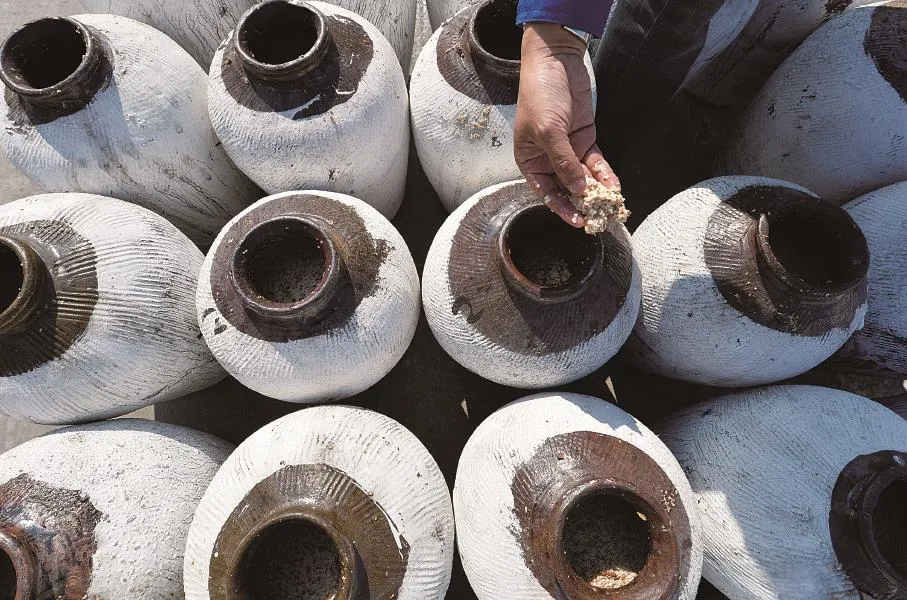The Journey of a Jar
The Journey of a Jar
In the eyes of Shaoxing craftsmen, every Huadiao jar has a story, and the old wine in every jar has life.
Text & Photos by Wang Yuanchang & Yuan Yun Translation by Sonia
坛内乾坤
在绍兴匠人眼中,每一个花雕坛背后都有故事,每一坛的老酒都在呼吸。
Huadiao by Jars
At the south of the Yangtze River and among the Chinese communities around the world, there is the custom of giving away Huadiao Rice Wine on special occasions such as weddings, having newborns, moving to new houses, celebrating the seniors' birthdays, worshipping the gods, praying for blessings, and so on. After the wine is flnished, the jars are kept as decorations in the house. As time passes, there is faint aroma of wine which fllls the whole room.
To this day, the name “Huadiao” represents more than a rice wine or a jar – it is a folk culture and an art.
I got to know Wang Yuelong, the inheritor of the Intangible Cultural Heritage“Shaoxing Huadiao,” through The Orchid Pavilion, masterpiece of famous calligrapher Wang Xizhi (303-361) on the wine jar. Wang Yuelong was the head of the Designing Offlce of winemaker Gu Yue Long Shan. It took him two months to realise the concept of demonstrating the art of Chinese calligraphy through Huadiao jars.
The raw material of Huadiao craftsmanship is from various minerals. Selfformulated clay is used to create a handmade sculpture on the surface of the jar. Artistic relief is made, followed by painting, depicting, and colour matching. Every Huadiao jar is completely handmade from the pottery coming freshly out of the oven to the flnished item. There are 6 major stages and over 20 steps, including sanding, base coating, powder sieving, sculpting, reflning, colouring, etc.
According to Wang Yuelong, patterns like the character “fu” (blessing), the hundred forms of “shou” (longevity), and the four blessings “fu shou xi lu”are the most popular on Huadiao jars during the holidays or on celebrating the birthdays of the elders. When it comes to being the “national gift” given away to other countries, the patterns adopted are mainly traditional Chinese attractions like the Great Wall, the four representing plants (plum blossoms, orchid, bamboo, and chrysanthemum), and so on. The Huadiao jars he exclusively designed for state banquets take the cloisonné element: the four representing plants are created on the base colour of blue.
“The colour of pottery jars is the same originally. However, the sculptures vary because the devoted sculptors have different characteristics. Thus, every Huadiao jar is one of a kind,” says Wang Yuelong.

花雕论“坛”
中国江南乃至世界华人地区,结婚、生子、乔迁、拜寿、祭祀、祈福等都有送花雕酒坛的习俗。酒喝完,酒坛却保存下来,作为装饰摆放于屋中。久而久之,酒香便时常若有若无地飘散在整个房间。
时至今日,花雕已不仅仅是酒名、酒坛名,更是一种民俗文化和艺术珍品。
与非物质文化遗产“绍兴花雕”项目代表性传承人王岳龙结识,是缘自王羲之的《兰亭序》。时任古越龙山绍兴酒花雕厂设计室主任的王岳龙,当时历经两个月,实现了用花雕酒和花雕坛来展现中国书法艺术的构想。
花雕工艺原料取于矿物质,用自行配制的油泥作为堆塑的原料,在酒坛上进行手工堆塑雕刻,形成立体型高浮雕艺术风格,然后进行漆色描绘配色。每个花雕坛,从一个刚刚出炉的裸陶坛到最终成型,都是百分之百手工制作,并经过打磨、上色、沥粉、堆塑、精雕、彩绘等六大步骤20多道工序。
据王岳龙讲,逢年节、祝寿,花雕酒坛上多描绘“福” “百寿图” “福寿喜禄”等图案,再刻上祝福的话;而作为“国礼”用于国家之间的礼仪往来时,图案则主要以中国传统名胜如长城、传统名花如梅兰竹菊等为主要元素。在他设计的专供钓鱼台的花雕黄酒中,就融合了景泰蓝的元素,以蓝色为底色,创作出梅、兰、竹、菊四君子的图案。
“陶坛的颜色原本是一样的,但全身心投入创作的花雕师性格的不同,所雕出来的图案也不尽相同。所以,每一个花雕坛都是独一无二的。”王岳龙说。

Secrets of the “Wine Brains”
In Shaoxing, “Wine Brain” is the nickname for the brewers. One can feel the slippery and sticky texture in the air when getting to Tian Jiaben's home at the origin of Jian Lake located in southern Shaoxing. The rich aroma hits you in the face and one can get drunk without drinking.
68-year-old Tian Jiaben showed us his backyard, where pottery vats and jars are all over the place and several ceramic jars stand by the wall. Straw mats used to cover the vats were placed vertically at the corner of the wall; lotus leaves for sealing the jars were thoroughly scrubbed. Old pottery jars fllled with new wine were painted with lime powder water on the outside for sterilisation. Standing by a homemade wooden winepress at the centre of the yard, Tian's brothers were putting bags of fermented wort into the press. Tian walked up to spread the wort evenly in the press and turned to us, “When pressing the wort, the wort has to be placed evenly in the press, so the pressing can be done thoroughly and more liquid will come out of it.” That was when clear, light amber-coloured liquid dripped down from the bamboo tube at the side of the winepress into the heat-sterilised jar on the ground. Tian bent to catch a bowl of freshly pressed yellow rice wine and took a sip. “A taste of new wine allows me to judge how this making went and how long the wine can be preserved,” he said.
Tian Jiaben, born in a brewer family, has been making wine at Jian Lake Wine Factory since he was in his teens which was over 50 years ago. With all the brewing knowledge and technique, he is one of the “Wine Masters” at Shaoxing. According to Tian,“The climate, water and glutinous rice are all different each year, and the combination is even more complicated. The best yellow rice wine still rely on the experience of the “Wine Brains” and excellent ingredients – this once-a-year experience is way too valuable. The masters pass down the knowledge through verbal instructions. It must take ten, twenty years' expertise to make top-grade wine.”
“酒头脑”秘笈
在绍兴,“酒头脑”是酿酒师傅的代称。来到位于绍兴城南鉴湖源头的“酒头脑”田家本家时,立刻感觉到空气中有种滑腻腻的触感,浓厚的香气扑面而来,人未醉而神先迷。
68岁的田家本带我们来到他家后院,只见一地的陶缸、陶罐,墙边立着几个大瓷坛。盖缸的稻草帘子整齐地立在墙角,封坛口的荷叶被洗得干干净净。装新酒的老陶坛外面还被涂上了一层起着杀菌效果的白灰水。院中央一个自制的木质传统榨箱旁,田家本的兄弟正在往榨箱里装一袋袋已经发酵好的酒醪。田家本上前将榨箱里的酒醪铺匀,回头告诉我们:“榨酒时,装料一定要均匀,压榨时才能榨得彻底,多出酒。”只见清澈透明的淡琥珀色液体,缓缓地从榨箱旁圆竹管里流到地上的经加热杀菌过的坛子里。田家本弯下腰,接了一碗刚榨出来的黄酒,小抿一口。“尝尝新酒的味道,判断一下这次酿得怎样,能存多久。”他说。
出身于酿酒世家的田家本十几岁就在鉴湖酒厂酿酒,至今已有50多年了,深谙酿酒技巧精髓的他在绍兴属“酒师级”人物了。据他讲,“每年的气候、水、糯米都不一样,组合起来就更加复杂了,最好的黄酒还是靠‘酒头脑’们的经验和优良的原料,这些一年只能积累一次的经验实在太珍贵了。需要师傅对徒弟的口授相传,若要酿得上乘的好酒,非十年二十年的功夫不可。”

Wine Masters' Expertise酿酒师的真功夫
1 Mindset: From the stage of making brewing yeasts to that of steaming wine and sealing the jars, the masters have to remain mellow and calm. The mentality determines the level of the wine.
心功:从做酒药起,至煎酒封坛,都要保持心平气和。心态决定酒的“境界”。
2 Sense of touch: The craftsmen are able to tell the fermentation temperature with one finger, like Chinese medical doctors feel a pulse, and never make any mistakes. Although most of the brewers nowadays cannot work without thermometers, old craftsmen are still used to thrust their index fingers quickly into fermented liquid to feel.
指功:工匠们如同中医把脉,凭借一根手指,就可感知发酵温度,决不会有丝毫偏离。现在虽然更多的酿酒人离不开温度计,但老匠人还习惯将食指迅捷地插进发酵的浆液中去感知。
3 Sense of taste: At the initial fermentation stage, the brewers watch closely the growth and chemistry among different yeasts 24/7. Changes like sugar content and acidity can be instantly grasped by their tongues.
舌功:黄酒前发酵阶段,酿酒师要24小时调控各菌种生长和相互作用,凭借舌尖,可以快速感知把握糖度、酸度等变化。
4 Observation: In the initial fermentation stage, popping sounds keep coming out of the vats, and bubbles of all sizes burst. Colours and features are constantly changing. Learning the fine progression along the way via scientific methods, craftsmanship starts with the eyes.
眼功:十年甚至二十年方可学到手的酿酒秘笈,就是善于用眼观察。前发酵阶段,缸中咕咕噜噜作响,大大小小冒泡,颜色、特征不断变化,科学把握细微的渐进,匠心尽在眼中。

